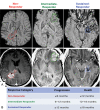Using susceptibility-weighted imaging to determine response to combined anti-angiogenic, cytotoxic, and radiation therapy in patients with glioblastoma multiforme
- PMID: 23393208
- PMCID: PMC3607266
- DOI: 10.1093/neuonc/nos325
Using susceptibility-weighted imaging to determine response to combined anti-angiogenic, cytotoxic, and radiation therapy in patients with glioblastoma multiforme
Abstract
Background: The goal of this study was to investigate whether the amount of hypointense signal on susceptibility-weighted imaging within the contrast-enhancing lesion (%SWI-h) on the pretreatment scan could determine response in patients with newly diagnosed glioblastoma multiforme who received external beam radiation therapy with concomitant anti-angiogenic therapy (enzastaurin) and cytotoxic chemotherapy (temozolomide).
Methods: Twenty-five patients were imaged before therapy (postsurgical resection) and scanned serially every 2 months until progression. Standard clinical MR imaging and SWI were performed on a 3T scanner. %SWI-h was quantified for each patient's pretreatment scan. Time to progression and death were used to characterize patients into non-, immediate-, and sustained-response groups for both events. Cox proportional hazards models were used to assess the association between %SWI-h and both progression-free survival (PFS) and overall survival (OS). Classification and regression tree analysis were used to determine optimal cutoffs on which to split %SWI-h.
Results: For both death- and progression-based response categories, %SWI-h was significantly higher in sustained responders than in nonresponders. Cox model coefficients showed an association between %SWI-h and PFS and OS, both in univariate analysis (PFS: hazard ratio [HR] = 0.966, 95% confidence interval [CI] = 0.942-0.988; and OS: HR = 0.945, 95% CI = 0.915-0.976) and when adjusting for baseline KPS, age, sex, and resection extent (PFS: HR = 0.968, 95% CI = 0.940 -0.994; and OS: HR = 0.943, 95% CI = 0.908 -0.976). A cutoff value of 38.1% significantly differentiated patients into 2 groups based on censored OS and into non- and intermediate-response categories based on time to progression.
Conclusions: These early differences suggest that SWI may be able to predict which patients would benefit most from similar combination therapies and may assist clinicians in making important decisions about patient care.
Figures





Similar articles
-
Phase II and pharmacogenomics study of enzastaurin plus temozolomide during and following radiation therapy in patients with newly diagnosed glioblastoma multiforme and gliosarcoma.Neuro Oncol. 2011 Dec;13(12):1331-8. doi: 10.1093/neuonc/nor130. Epub 2011 Sep 6. Neuro Oncol. 2011. PMID: 21896554 Free PMC article. Clinical Trial.
-
Survival benefit of levetiracetam in patients treated with concomitant chemoradiotherapy and adjuvant chemotherapy with temozolomide for glioblastoma multiforme.Cancer. 2015 Sep 1;121(17):2926-32. doi: 10.1002/cncr.29439. Epub 2015 May 14. Cancer. 2015. PMID: 25975354
-
Post-chemoradiation volumetric response predicts survival in newly diagnosed glioblastoma treated with radiation, temozolomide, and bevacizumab or placebo.Neuro Oncol. 2018 Oct 9;20(11):1525-1535. doi: 10.1093/neuonc/noy064. Neuro Oncol. 2018. PMID: 29897562 Free PMC article. Clinical Trial.
-
Angiogenesis inhibitors effects on overall survival and progression-free survival in newly diagnosed primary glioblastoma multiforme: a meta-analysis of twelve randomized clinical trials.J Neurooncol. 2025 Jan;171(2):313-328. doi: 10.1007/s11060-024-04865-2. Epub 2024 Dec 5. J Neurooncol. 2025. PMID: 39636552 Review.
-
Cerebellar glioblastoma: a retrospective review of 21 patients at a single institution.J Neurooncol. 2011 Dec;105(3):555-62. doi: 10.1007/s11060-011-0617-2. Epub 2011 Jun 4. J Neurooncol. 2011. PMID: 21643841 Review.
Cited by
-
The role of imaging in radiation therapy planning: past, present, and future.Biomed Res Int. 2014;2014:231090. doi: 10.1155/2014/231090. Epub 2014 Apr 10. Biomed Res Int. 2014. PMID: 24812609 Free PMC article. Review.
-
[Towards more precision in the therapy of brain tumors. Possibilities and limits of MRI].Nervenarzt. 2015 Jun;86(6):701-2, 704-9. doi: 10.1007/s00115-015-4313-x. Nervenarzt. 2015. PMID: 26017379 German.
-
Lessons from anti-vascular endothelial growth factor and anti-vascular endothelial growth factor receptor trials in patients with glioblastoma.J Clin Oncol. 2015 Apr 1;33(10):1197-213. doi: 10.1200/JCO.2014.55.9575. Epub 2015 Feb 23. J Clin Oncol. 2015. PMID: 25713439 Free PMC article.
-
An update on susceptibility-weighted imaging in brain gliomas.Eur Radiol. 2024 Oct;34(10):6763-6775. doi: 10.1007/s00330-024-10703-w. Epub 2024 Apr 6. Eur Radiol. 2024. PMID: 38581609 Review.
-
Intra-tumoral susceptibility signals in brain gliomas: where do we stand?Front Radiol. 2025 Feb 20;5:1546069. doi: 10.3389/fradi.2025.1546069. eCollection 2025. Front Radiol. 2025. PMID: 40052095 Free PMC article. Review.
References
-
- Folkman J. The role of angiogenesis in tumor growth. Semin Cancer Biol. 1992;3(2):65–71. - PubMed
-
- Amoroso A, Del Porto F, Di Monaco C, Manfredini P, Afeltra A. Vascular endothelial growth factor: a key mediator of neoangiogenesis. A review. Eur Rev Med Pharmacol Sci. 1997;1(1–3):17–25. - PubMed
-
- Damert A, Machein M, Breier G, et al. Up-regulation of vascular endothelial growth factor expression in a rat glioma is conferred by two distinct hypoxia-driven mechanisms. Cancer Res. 1997;57(17):3860–3864. - PubMed
-
- Wesseling P, Ruiter DJ, Burger PC. Angiogenesis in brain tumors; pathobiological and clinical aspects. J Neurooncol. 1997;32(3):253–265. - PubMed
Publication types
MeSH terms
Substances
Grants and funding
LinkOut - more resources
Full Text Sources
Other Literature Sources
Medical

